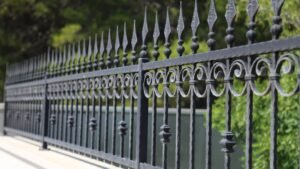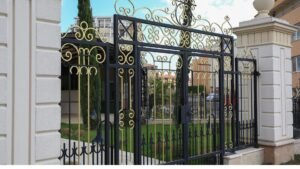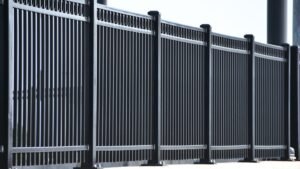Welcome to our in-depth comparison of aluminium and wood gates, where we’ll help you decide which material is best suited for your needs. Choosing the right gate for your home can be a daunting task, especially when faced with options that offer different benefits in terms of durability, maintenance, cost, aesthetics, and eco-friendliness. In this post, we’ll break down the pros and cons of aluminium and wood gates, giving you all the information you need to make an informed decision. Whether you’re looking for a modern, low-maintenance solution or prefer the timeless charm of natural wood, we’ve got you covered.
Aluminium gates are more durable, low-maintenance, and resistant to weather conditions, making them a long-lasting option. In contrast, wood gates offer a classic, natural aesthetic but require more upkeep to prevent rot, warping, and damage from pests. Aluminium is ideal for those seeking modern designs and minimal maintenance, while wood is better suited for traditional looks and soundproofing. Ultimately, the choice depends on your priorities, such as durability, cost, and aesthetic preference.
Table of Contents
Durability And Strength Comparison
When choosing materials for outdoor projects like gates, fences, or even furniture, durability is a key factor. Two popular options are aluminium and wood, each with its unique strengths and weaknesses. In this section, we’ll take a closer look at how they measure up when it comes to standing the test of time and handling harsh environmental conditions.
Which is More Durable? Aluminium vs. Wood
Aluminium’s Durability
Aluminium is widely known for its exceptional durability, especially in outdoor applications. One of its standout features is its corrosion-resistant properties. Unlike other metals that may rust over time, aluminium forms a protective oxide layer when exposed to the elements, preventing it from corroding. This makes it an excellent choice for outdoor structures that need to endure various weather conditions, such as rain, heat, and snow.
Aluminium can also handle temperature fluctuations well. In areas that experience extreme heat or freezing temperatures, aluminium remains structurally sound without warping or cracking. Its low-maintenance nature is a huge advantage—aluminium installations don’t require frequent treatments or coatings to maintain their durability, making them a “set it and forget it” option for homeowners.
Wood’s Durability
On the other hand, wood, while a traditional and often aesthetically pleasing material, can face significant challenges when exposed to the elements. Wood is susceptible to rot when it absorbs moisture over time, especially in areas with high humidity or heavy rainfall. If left untreated, wood is also vulnerable to warping, meaning it may bend or twist as it swells and shrinks with changing temperatures and moisture levels.
Another downside to wood is its attraction to pests. Termites and other insects can severely damage untreated wood, compromising its structural integrity. Even treated wood, though better protected, will still require consistent upkeep like sealing, staining, and repainting to maintain its appearance and durability over the years.
Long-Term Performance
When it comes to long-term performance, aluminium clearly has the upper hand. Over time, aluminium retains its shape, strength, and appearance with minimal maintenance. The material remains unaffected by most environmental conditions and shows little wear and tear, even after years of exposure.
Wood, however, tells a different story. Though it may start off strong, the constant threat of moisture, pests, and temperature changes can cause it to deteriorate without regular care. Even treated wood needs periodic maintenance to maintain its durability and strength, making it a more time-consuming option in the long run.
Real-Life Example: Aluminium vs. Wood in Coastal Areas
Consider a scenario where a homeowner is looking to install a gate in a coastal area. Coastal environments can be particularly harsh due to the salt air, which accelerates corrosion in many materials. In this case, an aluminium gate would perform significantly better than a wooden one. The natural corrosion-resistant properties of aluminium make it ideal for withstanding salty, humid conditions without deteriorating. In contrast, a wooden gate would require frequent treatment to avoid moisture absorption and potential rot, making it more of a maintenance burden for the homeowner.
In summary, while wood has its charm and place in certain projects, aluminium’s superior durability and low-maintenance characteristics make it the clear winner in most outdoor applications. If you’re looking for a long-lasting, weather-resistant solution, aluminium is the way to go.
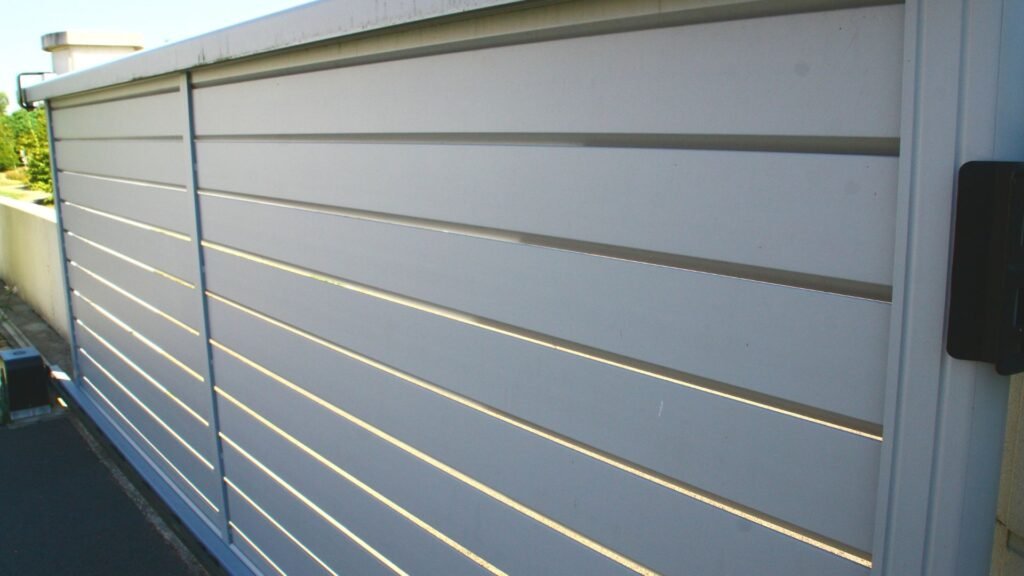
Maintenance Requirements
What Kind of Upkeep Do These Gates Need?
When selecting the right gate for your property, understanding the maintenance involved is essential. Different materials come with varying levels of upkeep, which can significantly impact both your time and budget in the long run. Let’s explore the specific maintenance requirements for two popular gate materials—aluminum and wood—and break down how much effort each one will demand over time.
Aluminium Maintenance: Low-Maintenance and Long-Lasting
One of the biggest advantages of aluminium gates is their incredibly low-maintenance nature. If you’re someone who prefers minimal upkeep, aluminium gates are an excellent choice. Unlike wood, aluminium doesn’t warp, crack, or suffer from pest infestations, making it highly durable with little to no attention needed.
To keep aluminium gates looking fresh and performing well, all you really need is an occasional cleaning. A simple wash with water and mild soap a few times a year will help remove dust, dirt, and any environmental grime that accumulates over time. This routine takes just minutes and can easily be done by the homeowner, meaning there are no long-term commitments or hidden costs. Best of all, aluminium is resistant to rust and corrosion, meaning it can last for many years without requiring any additional treatments or repairs.
Wood Maintenance: Requires Regular Care and Attention
In contrast, wood gates, while stunning and full of character, require a lot more attention. Wood is a natural material, which means it’s vulnerable to the elements, pests, and general wear and tear. Keeping a wood gate in top condition demands ongoing effort and investment.
First, wood gates need to be sealed and treated regularly to protect them from moisture. Without this protective layer, the gate can absorb water, leading to swelling, warping, or even rotting. Depending on your local climate, you may need to re-seal or paint the gate every one to three years. In addition, wood is prone to pests like termites, which means occasional treatments against infestations are also necessary.
The aesthetic appeal of a wood gate is undeniable, but maintaining that look can be time-consuming. Besides sealing and pest treatments, regular inspections for cracks, splits, or other signs of damage are necessary to catch issues before they become bigger problems.
Time and Cost Considerations: Aluminium vs. Wood
When comparing the time and cost required to maintain aluminium versus wood gates, the difference is significant. Aluminium gates, as mentioned, require minimal maintenance and can be cleaned with DIY methods, making them a cost-effective option in the long run. The time spent on aluminium gate upkeep is negligible compared to wood, and you’re unlikely to face any major repair bills over the years.
On the other hand, wood gates can become a costly commitment. Not only will you need to spend time maintaining them, but you may also have to hire professionals for treatments, sealing, painting, or repairs. The cost of materials like high-quality sealants, paints, and treatments for pests adds up over time, making wood a more expensive choice in the long run.
While a wood gate may offer more charm and a traditional look, it’s important to weigh the ongoing time and financial investment required to keep it in good shape. For those who prefer a hassle-free solution, aluminium gates provide a sleek, modern appearance without the headaches of frequent maintenance.
When choosing between aluminium and wood gates, your decision should factor in not just the initial aesthetic appeal, but also the long-term upkeep. Aluminium gates offer a low-maintenance, durable solution with minimal costs, while wood gates, though beautiful, demand regular care and investment. By understanding the maintenance requirements of each material, you can make an informed decision that suits your lifestyle and budget for years to come.

Cost Comparison
When deciding between aluminium and wood gates for your property, cost is a key factor that can influence your decision. It’s important to not only consider the initial expense but also the long-term financial implications. Let’s break down the cost comparison between aluminium and wood gates to help you make an informed choice.
Initial Cost
The upfront cost of a gate is often the first concern for many homeowners. In many cases, wood gates tend to be more affordable at the time of purchase. The price of wood varies depending on the type of wood you choose—softwoods like pine are generally less expensive than hardwoods such as oak or cedar. Additionally, the installation process for wood gates is often simpler, which can lead to lower labor costs compared to aluminium.
However, aluminium gates typically come with a higher price tag initially. The material itself is more expensive, and the installation might require specialized labor, increasing the overall initial cost. But it’s essential to look beyond just the initial outlay when comparing the true value of aluminium versus wood.
Long-Term Investment
When evaluating the long-term financial impact, wood gates often require ongoing maintenance. Wood is a natural material that is vulnerable to weather conditions, rot, insect damage, and warping. Regular sealing, staining, or painting is necessary to keep wood gates looking their best and to protect them from the elements. These maintenance activities not only take time but also come with recurring costs. Over time, the expenses for repairs and maintenance can add up, and you may even need to replace a wood gate entirely after several years of wear and tear.
On the other hand, aluminium gates offer exceptional durability with very low maintenance requirements. Aluminium is resistant to rust, corrosion, and weathering, making it ideal for long-term outdoor use. While the initial investment is higher, aluminium gates can last for decades with minimal upkeep. Occasional cleaning might be all that’s needed to maintain their appearance. This means that, in the long run, aluminium gates often save homeowners money on repairs, maintenance, and replacements.
Return on Investment (ROI)
Beyond the costs of purchase and upkeep, it’s important to consider the return on investment (ROI) of your gate. Aluminium gates not only last longer, but they also add a sleek, modern aesthetic that can enhance your property’s curb appeal. A well-maintained aluminium gate can increase your home’s value, making it a smart investment if you’re looking to boost the resale value or simply want to make a lasting impression.
While wood gates can add a classic, rustic charm to your property, they may not offer the same long-term value as aluminium due to the ongoing maintenance costs and potential for wear over time. If you’re planning on selling your property in the future, the durability and low-maintenance nature of aluminium gates may appeal to potential buyers, offering a higher ROI.
In summary, while wood gates might be more cost-effective in terms of initial expense, the ongoing maintenance and potential for early replacement can increase their overall cost in the long term. Aluminium gates, though more expensive upfront, offer significant savings over time due to their durability, low maintenance, and ability to retain their appearance and functionality for years. If you’re looking for a long-term investment that adds value to your property, aluminium gates are the more cost-effective option in the bigger picture.

Aesthetic Appeal
Aluminium’s Modern Look vs. Wood’s Timeless Appeal
When it comes to choosing the right gate material for your home, aesthetics play a key role. The visual impact of your gate can complement or contrast with your home’s architecture, creating either a seamless flow or a striking statement. Two of the most popular gate materials, aluminium and wood, each offer distinct aesthetic benefits. Let’s dive into their visual appeal and explore how both materials can enhance the look of your property.
Aluminium Gates Aesthetics
Aluminium gates are favored for their sleek, modern appearance, making them an ideal choice for homeowners who want a contemporary touch. With clean lines and a minimalist profile, aluminium gates naturally exude a sense of modernity and sophistication.
One of the greatest advantages of aluminium gates is their versatility in terms of customization. Available in a wide array of designs, finishes, and colors, aluminium can be tailored to match any home style, from urban chic to industrial minimalism. Even more impressive is the ability to powder coat aluminium gates in a way that mimics other materials, such as wood. This allows homeowners to enjoy the clean look of metal while maintaining the warmth and charm of wood, offering a balance between modern aesthetics and traditional appeal. This customization also extends to the finishes, ranging from matte to glossy, allowing you to match the gate’s look with other exterior elements of your home.
Wood Gates Aesthetics
On the other hand, wood gates have long been admired for their timeless, natural beauty. They bring warmth and a rustic, earthy feel to any property, making them a popular choice for country-style homes or residences with traditional architecture. The unique grains and textures of wood create a sense of authenticity and craftsmanship, which is difficult to replicate with synthetic materials. Wood gates are often seen in homes that embrace a classic or cottage-inspired aesthetic, where natural elements are part of the overall design language.
Wood’s natural feel is not only visually appealing but also emotionally resonant. It evokes a sense of comfort and tradition, often making the entrance to a home feel more inviting and approachable. The rich tones of wood—whether left in their natural state or stained—add character and depth, making it a great option for homeowners who value aesthetics with heritage or cultural significance.
Customization Options
When it comes to customization, both aluminium and wood offer significant flexibility, but in different ways. Aluminium is prized for its ability to be shaped and finished in nearly any form, giving it the edge in terms of design versatility. As mentioned earlier, powder coating techniques allow aluminium to mimic the look of wood, offering homeowners the best of both worlds: the durability and low maintenance of aluminium combined with the warm, classic appearance of wood.
Wood gates, meanwhile, can be stained or painted in a variety of shades, allowing for customization that highlights its natural texture or transforms its look to match the surrounding environment. While wood can be carved or shaped to create intricate designs, it does require more maintenance to preserve its beauty over time. However, for those who appreciate the craftsmanship and rich detail that wood offers, the occasional upkeep may be worth the effort.
Neighborhood Aesthetics
The choice between aluminium and wood also depends on how well the gate material complements the surrounding neighborhood aesthetics. Aluminium gates tend to work well in urban or modern suburban settings, where sleek lines and minimalist designs are more common. In contrast, wood gates are often better suited to rural or traditional neighborhood settings, where a natural, rustic look fits the overall environment.
Additionally, aluminium gates offer the flexibility to fit into a wide range of architectural styles, from modern homes with glass facades to minimalist homes with metal accents. Meanwhile, wood gates often enhance homes that draw from classic architectural elements, such as stone walls, shingle siding, or gabled roofs.
In conclusion, both aluminium and wood gates bring unique aesthetic qualities to your home, and the decision ultimately depends on the style you wish to achieve. Whether you opt for the modern, customizable appeal of aluminium or the timeless, inviting look of wood, either material has the potential to significantly elevate your property’s curb appeal.

Eco-Friendliness And Sustainability
When choosing materials for a project, it’s essential to consider their impact on the environment. Both aluminium and wood have pros and cons when it comes to sustainability, but which one is the more eco-friendly choice? Let’s dive deeper into each material’s environmental footprint and how they compare over their lifecycle.
Aluminium’s Sustainability
Aluminium is widely regarded as a highly sustainable material, primarily because it is 100% recyclable. This means that once aluminium has served its purpose, it can be recycled and reused repeatedly without losing its inherent qualities. The recycling process also uses significantly less energy than the original production. In fact, recycling aluminium saves up to 95% of the energy required to produce new aluminium from raw materials.
Additionally, modern manufacturing techniques have evolved to minimize the environmental impact of aluminium production. Smelting, which once had a reputation for high energy consumption and pollution, has become more efficient, with many facilities now using renewable energy sources such as hydropower. This shift reduces the overall carbon footprint associated with aluminium production, making it a greener option over time.
Wood’s Sustainability
Wood, on the other hand, is a renewable resource, which is a major point in its favor. Forests, when managed responsibly, can be replenished, making wood a sustainable choice. When harvested and processed without harmful chemicals, wood has a relatively low environmental impact compared to other materials. Its production requires less energy and results in lower emissions compared to materials like steel or plastic.
However, the sustainability of wood is heavily dependent on sourcing and treatments. Deforestation, illegal logging, and poor forest management can significantly damage ecosystems, leading to biodiversity loss and increased carbon emissions. Furthermore, many types of wood undergo chemical treatments to enhance durability, which can introduce harmful substances into the environment.
To ensure that wood is sourced sustainably, it’s crucial to look for certifications such as FSC (Forest Stewardship Council), which ensures that the wood comes from responsibly managed forests. Using reclaimed or recycled wood can also help reduce the environmental impact of your projects.
Environmental Impact Over Time: Aluminium vs. Wood
When comparing the overall environmental impact of aluminium and wood, we must look beyond just the raw materials and examine the entire lifecycle—from production to disposal.
Aluminium tends to have a higher environmental impact during its initial production due to the energy-intensive process of extracting it from bauxite ore. However, its long lifespan and recyclability make it a strong contender for sustainability. Aluminium products are often more durable and require less maintenance, which reduces the need for frequent replacement. Over time, aluminium’s ability to be recycled infinitely with minimal energy input outweighs its initial production cost.
Wood, by contrast, has a lower environmental cost during production but can have drawbacks depending on how it’s sourced and treated. Untreated wood biodegrades naturally, but treated wood, often used in construction or furniture, can release harmful chemicals into the environment over time. Additionally, while wood is renewable, irresponsible sourcing practices can lead to environmental degradation.
Ultimately, the sustainability of either material depends on how it is produced, used, and disposed of. Aluminium’s high recyclability and long lifespan make it a strong choice for eco-conscious consumers, while wood’s renewability and low production emissions make it a viable option when sourced responsibly.
Choosing between aluminium and wood depends on the specific application and long-term environmental considerations. For those prioritizing durability and recyclability, aluminium is often the better choice. But for projects where the natural aesthetic and renewable qualities of wood are essential, opting for responsibly sourced wood can provide a more sustainable option.

Security And Privacy Features
Which Material Offers Better Security and Privacy?
When it comes to selecting a gate for your property, security and privacy are top priorities. The choice between aluminium and wood gates can significantly impact these aspects, and understanding the differences between these two materials can help you make an informed decision based on your specific needs.
Aluminium Gates for Security
Aluminium gates are known for their strength, durability, and flexibility. One of the standout features of aluminium is its resistance to corrosion, making it a long-lasting material for outdoor use, even in harsh weather conditions. When paired with modern locking mechanisms and automation, aluminium gates can provide an excellent level of security for homes and businesses.
Strength and Flexibility: Aluminium gates, despite being lightweight compared to other metals, are incredibly strong. This material can withstand significant force, making it harder for intruders to break through. Moreover, its flexibility allows for the incorporation of advanced security features, such as electric locks, keypads, and smart access systems. These automated systems can be controlled remotely, providing an added layer of convenience and security for homeowners who want to monitor and manage gate access in real time.
Design Versatility and Security: Aluminium gates are also highly customizable, which allows property owners to choose designs that not only look modern but also serve their security needs. For example, while some designs may have a more open aesthetic, homeowners can opt for thicker bars or panels to reduce visibility while still benefiting from the strength of the material. Additionally, the availability of automated aluminium gates adds further deterrence to potential intruders, as these gates can often be integrated with home security systems.
Wood Gates for Privacy
For those who prioritize privacy, wood gates offer a completely different set of advantages. Wood gates are often solid structures, providing full coverage that effectively blocks any outside view. This makes them an ideal choice for families who value their privacy and want to keep their property hidden from passersby.
Solid Structure for Maximum Privacy: The natural structure of wood makes it perfect for creating an impenetrable barrier. Unlike some aluminium designs that may include gaps or spaces between panels, wood gates are typically constructed to be solid from top to bottom. This means no one can see through, making it an excellent option for homeowners seeking complete privacy in their front yard or driveway.
Aesthetic Appeal: Wood gates also offer a timeless, traditional appearance that can enhance the overall look of your property while delivering privacy. With the right choice of wood type and finish, a wooden gate can blend seamlessly with natural surroundings, fences, or garden features, offering a warm and welcoming feel without compromising on privacy.
Use Case Scenarios
For Families Prioritizing Privacy: If your primary concern is keeping your home and family away from prying eyes, a wood gate is an optimal choice. Whether it’s in a suburban setting where homes are closer together or in a more remote area where visibility into your property is possible, wood gates create an effective privacy shield. This option is especially appealing for those with young children or pets, where privacy from neighboring properties or pedestrians is a key consideration.
For Those Prioritizing Security: On the other hand, aluminium gates are the go-to for those who place security at the forefront. With modern locking systems, remote control access, and the inherent strength of aluminium, these gates can effectively safeguard your property from intrusions. Aluminium’s low maintenance requirements also make it a cost-effective, long-term solution for homeowners who want to combine security with a sleek, contemporary design.
Ultimately, the choice between aluminium and wood gates comes down to your specific needs regarding security and privacy. Aluminium gates offer cutting-edge security features and durability, while wood gates provide superior privacy with a classic, solid design. By carefully considering your lifestyle, the layout of your property, and the level of security or privacy you need, you can make an informed decision that enhances both the functionality and aesthetic of your home.
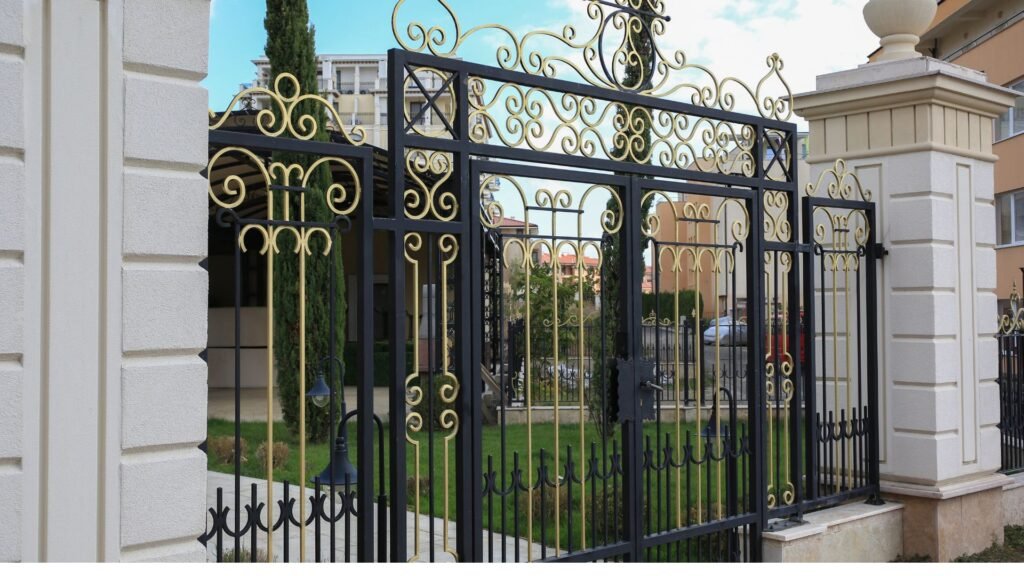
Weather Resistance
How Do These Materials Hold Up to the Elements?
When choosing materials for outdoor projects, it’s crucial to understand how well they withstand the forces of nature. The performance of aluminium and wood under different weather conditions varies significantly, and knowing their strengths and weaknesses will help you make the right choice depending on where you live and what your project demands.
Aluminium in All Climates
Aluminium is an exceptional choice for outdoor projects, especially when it comes to weather resistance. This material is naturally rust-proof, making it an ideal option for environments that experience heavy rainfall or high humidity levels. Unlike iron or steel, aluminium doesn’t corrode when exposed to water, which makes it perfect for coastal areas or regions with a lot of precipitation.
Moreover, aluminium is incredibly lightweight, allowing for easier installation and transportation without sacrificing durability. It holds up well under extreme conditions, whether that means freezing snow or scorching heat. Its resistance to UV rays ensures that it won’t warp, crack, or fade under prolonged sun exposure. This makes it a versatile, long-lasting solution, whether you’re dealing with rainstorms, harsh winters, or relentless summer heat.
Wood’s Vulnerability to Weather
Wood, while aesthetically pleasing and often preferred for its natural, warm look, has a more complex relationship with the elements. One of the main challenges with wood is its susceptibility to moisture. When exposed to rain, snow, or high humidity, wood tends to absorb water, leading to swelling. Over time, this can cause cracking, warping, or even rotting.
In dry, hot conditions, untreated wood may become brittle and prone to cracking due to heat exposure. While various treatments such as sealants, stains, and paints can help protect the wood and prolong its life, these measures only delay the inevitable. Even with regular maintenance, wood will eventually degrade if constantly exposed to harsh weather. It’s especially risky in coastal areas where saltwater and constant moisture accelerate wood’s deterioration.
Geographic Considerations
When selecting materials based on climate, aluminium tends to be a superior choice in coastal areas where salt, humidity, and moisture are common. Its resistance to rust and corrosion makes it perfect for these conditions, while its light weight makes it easier to work with on-site.
For inland regions with less humidity and less moisture, wood might still be a viable option, especially if you’re willing to invest in ongoing maintenance to keep it protected. However, aluminium would still offer better long-term performance with less upkeep in hot or dry climates where UV rays can affect untreated wood.
In conclusion, while both materials have their benefits, aluminium offers superior weather resistance across all climates, making it a smart, low-maintenance choice for long-term outdoor use. Wood, while beautiful, may require more attention and care to withstand the elements, especially in more extreme environments. The right choice depends on your location and how much maintenance you’re prepared to take on to keep your outdoor space looking its best.
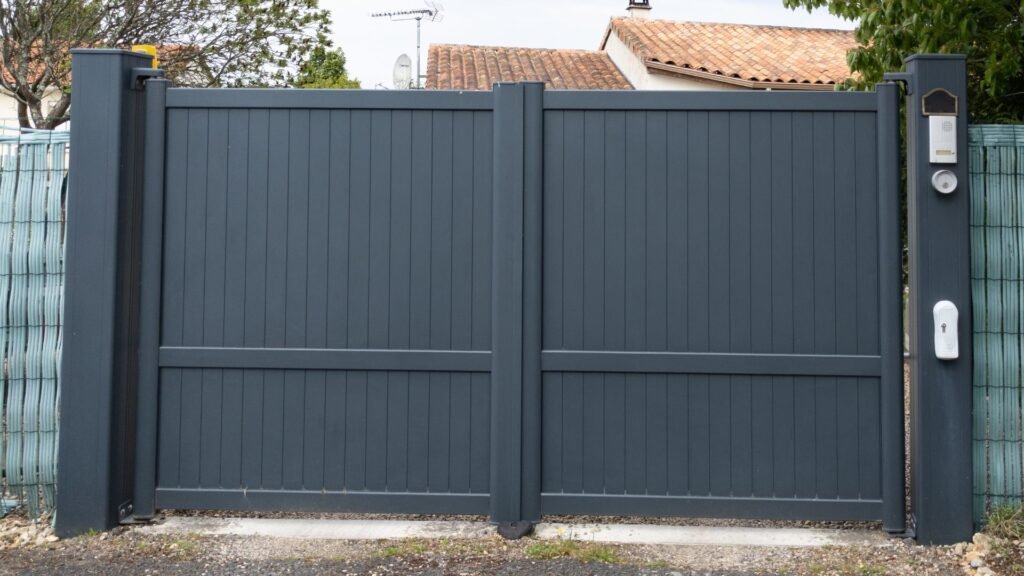
Ease Of Installation
How Easy is it to Install Aluminium vs. Wood Gates?
When deciding between aluminium and wood gates, one key factor that often gets overlooked is the ease of installation. Understanding how each material differs in terms of installation requirements can help you make a more informed decision, especially if you’re trying to balance budget, time, and effort. Let’s dive into the pros and cons of installing aluminium gates compared to wood gates, and the impact that choice might have on whether you can handle it yourself or need professional help.
Aluminium’s Lightweight Advantage
One of the biggest benefits of aluminium gates is how lightweight they are. Aluminium, as a material, is significantly lighter than wood, making it much easier to handle during the installation process. Whether you’re dealing with a single gate or a double gate setup, the lower weight of aluminium means less strain on the supporting structures, such as posts and hinges. In many cases, you can get away with using lighter-duty hardware, and the installation can often be completed in less time compared to wood.
This lightweight nature also allows for more flexibility during installation. It’s easier to maneuver, lift, and position the gate without requiring multiple people or heavy machinery. For homeowners considering a DIY approach, the lightweight nature of aluminium is a huge advantage—it makes the task more approachable without the need for specialized tools or extra hands. This simplicity can lead to reduced labor costs if you choose to hire a professional, as they’ll likely spend less time on the job, and it minimizes the structural reinforcements needed for the gate, which can further reduce your overall costs.
Wood Installation
On the other hand, wood gates, while offering a classic and timeless aesthetic, are typically much heavier than aluminium. The weight of wood means that installing a wood gate usually requires more robust support systems, such as larger posts, stronger hinges, and additional brackets or reinforcements. This makes the process of installing wood gates more labor-intensive and time-consuming.
Because of the added weight, wood gates are harder to maneuver into place during installation, often requiring more than one person or even specialized equipment for larger gates. The heavier nature of wood can also put extra strain on the supporting structures over time, which may lead to additional maintenance costs in the long run. When choosing wood, you’ll likely need to invest in higher-grade installation hardware, which can increase the overall expense of the project. Plus, if the wood is not properly treated, it can warp, crack, or degrade over time, making proper installation even more critical to ensure long-term durability.
Professional vs. DIY Installation
The installation complexity of aluminium and wood gates can also influence whether you’ll need to hire a professional or if you can tackle the project yourself. Aluminium gates, due to their lighter weight and relatively straightforward installation process, are often more DIY-friendly. Many homeowners with basic tools and some handyman experience can successfully install an aluminium gate without too much trouble. That said, if you’re looking for a large gate or have uneven terrain, hiring a professional might still be the best route to ensure everything is properly aligned and secured.
Wood gates, by contrast, are more likely to require professional installation. The heavier weight and need for sturdier hardware increase the difficulty of a DIY installation. Additionally, because wood can expand or contract based on weather conditions, ensuring proper spacing and alignment during installation is key to preventing issues down the line. Hiring a professional may also be necessary to ensure that the wood gate is properly treated and sealed against the elements, adding to the long-term resilience of your investment.
In terms of costs, professional installation for both materials can vary. However, because wood gates often require more effort and specialized hardware, the cost of installation may be higher for wood than for aluminium. If you’re weighing the costs between the two, aluminium might offer savings both in terms of installation time and overall expenses, while wood could require a higher upfront investment.
In conclusion, aluminium gates generally offer an easier and quicker installation process due to their lightweight nature, making them more suitable for DIY installations and cost-effective in terms of labor. On the other hand, wood gates, while beautiful and sturdy, tend to be heavier, requiring more robust support, more specialized hardware, and often the expertise of a professional to ensure a seamless installation.
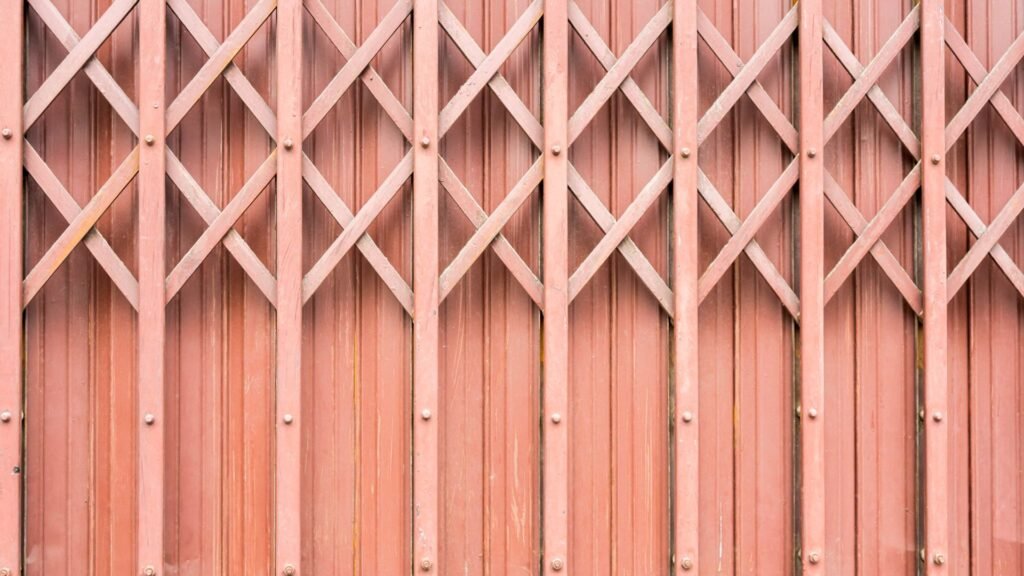
Noise And Sound Insulation
Which Material Offers Better Soundproofing?
When choosing between wood and aluminium for gates or barriers, soundproofing plays a crucial role in ensuring a peaceful environment. Both materials have different properties that affect their ability to block or minimize noise, so it’s important to understand how each one performs.
Wood’s Soundproofing Abilities
Wood is widely recognized for its excellent soundproofing abilities. Thanks to its dense and solid structure, wood can absorb and block sound waves more effectively than aluminium. The mass of wood helps reduce sound transmission, especially when thicker planks or panels are used. This characteristic makes wood a highly favorable option for those seeking noise reduction. If you’re installing wooden gates or fences, you’ll likely notice a significant difference in how much exterior noise is kept out. Wood’s ability to muffle sound is ideal in areas where privacy and quiet are essential, like residential settings or near busy streets.
Aluminium Gates and Noise
Aluminium, while durable and lightweight, doesn’t offer the same sound-blocking performance as wood. Its lighter nature can lead to sound reverberation or amplification. Additionally, aluminium gates are more prone to rattling or creating noise, especially in windy conditions. The design of the gate, such as whether it includes hollow sections or loose components, can exacerbate this issue, allowing noise to pass through more easily.
However, it’s important to note that aluminium gates can be quieter when designed and installed properly. Solid or reinforced aluminium constructions are less likely to cause issues with noise, but generally, aluminium is not as effective at minimizing sound as wood.
Solutions for Soundproofing
Both wood and aluminium gates can be enhanced for better sound insulation with a few adjustments. For wooden gates, you can increase the soundproofing effect by choosing thicker panels or adding insulation between layers of wood. Sealing gaps or cracks can also help block noise leakage. Applying weatherstripping is another way to reduce sound transmission.
For aluminium gates, preventing noise can be a bit more challenging but still manageable. One effective solution is to add padding or rubber seals to prevent the gate from rattling. Ensuring the gate is tightly secured with proper fittings can also reduce the potential for noise. Moreover, reinforcing hollow aluminium designs or opting for solid designs can help mitigate noise concerns.
In conclusion, if soundproofing is a top priority, wood tends to offer better noise reduction due to its dense structure. However, with the right enhancements and installation techniques, aluminium gates can also be made quieter.
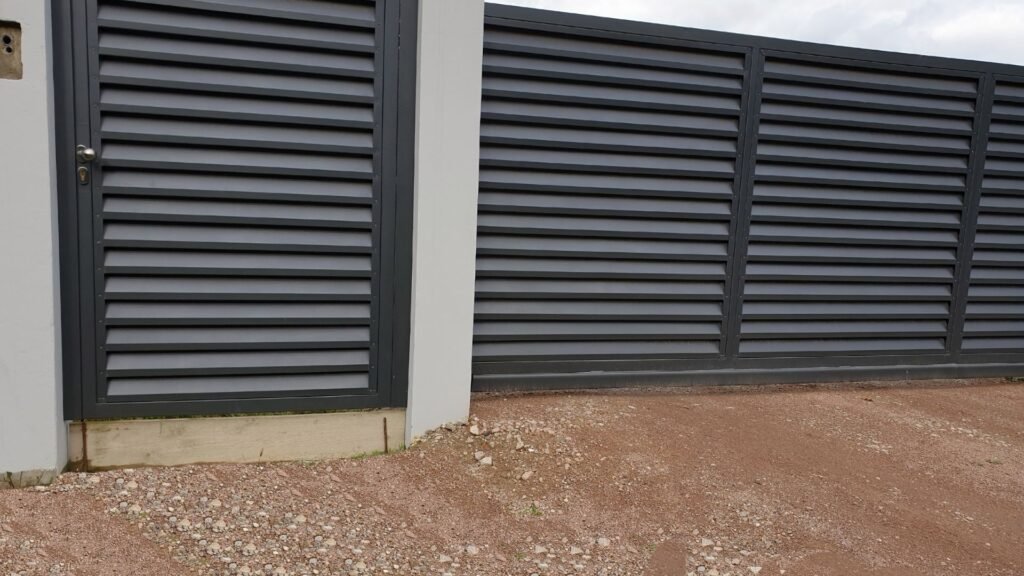
FAQs: About Are Aluminium Gates Better Than Wood
Are aluminium gates more durable than wood gates?
Yes, aluminium gates are more durable than wood gates. Aluminium is resistant to rust, corrosion, and weather damage, making it ideal for long-term outdoor use with minimal maintenance. Wood gates, while strong, can deteriorate over time due to moisture, rot, pests, and warping unless regularly maintained.
Do aluminium gates require less maintenance than wood gates?
Aluminium gates are much lower maintenance compared to wood gates. They only require occasional cleaning to remove dirt and debris, while wood gates need regular treatments such as sealing, painting, and pest protection to prevent deterioration.
Are wood gates more affordable than aluminium gates?
Wood gates can have a lower upfront cost compared to aluminium gates, especially if using standard timber. However, the ongoing costs of maintaining wood gates over time may make aluminium more cost-effective in the long run, as aluminium requires little to no maintenance.
Which material is more eco-friendly, aluminium or wood?
Both materials have eco-friendly aspects. Aluminium is fully recyclable and has a long lifespan, making it a sustainable option. Wood is a renewable resource, but concerns about deforestation and the chemical treatments needed for durability may affect its environmental impact. Recycled aluminium and sustainably sourced wood can enhance eco-friendliness for both options.
Can aluminium gates look like wood?
Yes, aluminium gates can be designed to mimic the appearance of wood. Powder coating techniques can give aluminium gates a wood-like finish, offering the aesthetic appeal of wood with the durability and low-maintenance benefits of aluminium.
Which gate material provides better privacy, aluminium or wood?
Wood gates typically offer better privacy since they are often solid and block visibility completely. Aluminium gates may feature more open, decorative designs that don’t fully block visibility, but there are also solid aluminium gate options available for privacy.
Are aluminium gates easier to install than wood gates?
Aluminium gates are generally easier to install because they are lighter than wood gates, requiring less structural support. This makes the installation process quicker and sometimes more cost-effective, especially for larger gates.
Do wood gates last as long as aluminium gates?
Wood gates typically have a shorter lifespan than aluminium gates, especially if not properly maintained. Aluminium gates can last several decades with minimal upkeep, whereas wood gates may require repairs or replacement after several years of exposure to the elements.
Which gate material is better suited for extreme weather conditions?
Aluminium gates are better suited for extreme weather conditions, as they are resistant to rust, corrosion, and temperature fluctuations. Wood gates, on the other hand, are more vulnerable to moisture, rot, and warping in extreme weather unless they are well-treated and maintained.
Which gate material is better for soundproofing, aluminium or wood?
Wood gates are generally better for soundproofing due to their solid, dense structure, which can block more noise than aluminium gates. Aluminium gates, especially those with open designs, may not offer the same level of sound insulation as wood.
Conclusion
In conclusion, when choosing between aluminium and wood gates, it’s important to consider the key differences in durability, maintenance, cost, aesthetics, eco-friendliness, and security. Aluminium gates are known for their low-maintenance requirements, modern appearance, and long-term durability, making them an excellent choice for those seeking a sleek, contemporary look with minimal upkeep. On the other hand, wood gates offer a traditional, natural aesthetic with superior sound insulation, though they may require more maintenance over time. Ultimately, your decision should be based on personal needs such as budget, local climate, and design preferences. For those unsure of the best option, consulting a professional can provide valuable insights. Don’t forget to bookmark this page for future reference or share it with someone else considering a gate purchase!
About the Author:
Mike Veail is a recognized digital marketing expert with over 6 years of experience in helping tradespeople and small businesses thrive online. A former quantity surveyor, Mike combines deep industry knowledge with hands-on expertise in SEO and Google Ads. His marketing strategies are tailored to the specific needs of the trades sector, helping businesses increase visibility and generate more leads through proven, ethical methods.
Mike has successfully partnered with numerous companies, establishing a track record of delivering measurable results. His work has been featured across various platforms that showcase his expertise in lead generation and online marketing for the trades sector.
Learn more about Mike's experience and services at https://theleadguy.online or follow him on social media:



